The Bible
Date added: 09/08/18
Bible and Society
Introduction
In July 2010 Christian Research sent professional interviewers to 44 locations throughout England and Wales to ask the population their views on the Bible. In total 1,013 people were interviewed, with the sample representative of the population as a whole. The research was conducted for Bible Society.
Here are some interesting findings from the research:
- 40% agreed the Bible is an influence for good in society
- 34% agreed we would be a much better society if more people engaged with the Bible
- The Bible most likely to be found in the home is a King James Version but most people would actually prefer to read the Good News Bible (rather than the KJV or NIV)
- Most people received their Bible 'passively', as a gift or passed on by a family member, only 21% 'actively' bought their own Bible
Bibles in the home
Just over half the sample recalled having a Bible in the household. This was higher amongst those claiming to be Christian, at 67%. In other words 2 out of every three Christians had a Bible in the household. One in five of those claiming another religion or no faith also had a Bible in the household. Amongst regular churchgoers the figure was 95%, and amongst those who hardly ever or never go it was 36%.
The figures for men and women were markedly different. Whilst only 45% of men interviewed recalled there was a Bible in the household, 59% of women reported a Bible in their household. Whilst some of this difference can be accounted for by single occupancy households where the women have Bibles and the men don’t, the figures for men and women living as couples are also different. We can only explain this in terms of the men being unaware that they have a Bible at home.
There was also a steep age gradient to the data. 69% of over 65s had a Bible at home, compared to only 39% of the under 44s.
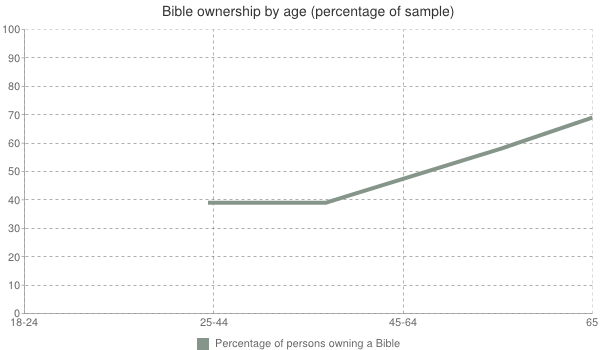
The average household has 1.1 Bibles. Those households that have a Bible have an average of 2.2 Bibles. Not only are men less likely to report the existence of a Bible in their home, they also report fewer copies. Men who had a Bible on average had 1.98 copies, whereas women had 2.14 on average. This would again point to greater awareness of Bibles in the home by women.
How Bibles got into the home
Only one in five who have a Bible bought it themselves (21%). The under 24 year olds were much less likely to buy their own Bible (10%).
36% have one that was a gift from a family member or friend and 30% have one that was passed on by a family member.
The type of Bibles people have
More than half did not know which version(s) they had at home. Amongst the 18-24s this was particularly noticeable with nearly 7 out of 10 claiming to not know. Even amongst the over 65s – the age group by far the most likely to know – only half knew which version they had.
Of those who thought they knew what version of Bible they had, 40% claimed it was a King James Bible, with a further 18% thinking they had the New King James version. The under 45’s were much less likely to have a King James version – 20% of 18-24 year olds and 26% of 25-44 year olds compared to 49% of 45-64 year olds and 44% of the over 65s.
Having asked respondents which Bible they thought they had at home, we then read out the same short passage from each of three versions (KJV, NIV and GNB) asked which of these was most like the one they had at home. Two different passages were used, each on half of the sample.
More than half thought their Bible was most like the King James, with 27% thinking theirs was more like the New International version and 20% going for the Good news Bible.
Where Bibles are kept
Nearly half kept a Bible in a bookcase (47%); a quarter (24%) beside their bed; 23% kept one in a drawer or cupboard, reasonably accessible. Others were to be found in handbags or briefcases and on coffee tables. Only 4% were hidden away in lofts and 5% elsewhere (most of which were accessible, such as child’s bedroom, study, front room table etc).
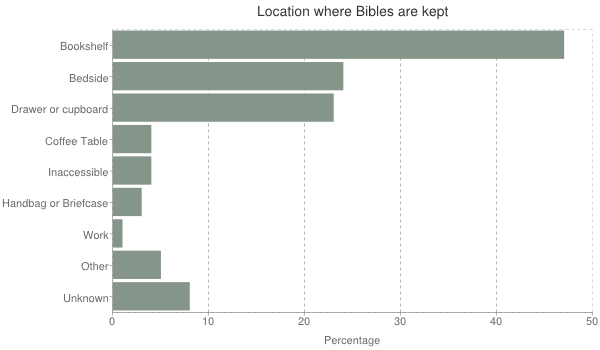
King James Version, New International Version or Good News Bible
We asked people to look at the same short passage from each of three versions (KJV, NIV and GNB). Two different passages were used, each on half of the sample.
We asked which of the three passages was the easiest to understand. The Good news Bible came out clearly on this score with 46% claiming this was the easiest to understand, only one in five thought the King James was easiest. In the youngest age group this dropped to 16%.
The differences were less marked when we asked which version of the passages respondents preferred to hear being read in public: Good News 38%, New International 34%, King James 27%. It seems there is room for all three versions, albeit with different individuals. Preferences by age and gender weren’t so marked, although men were more likely to prefer the Good News Bible.
When we asked which version they would prefer to read in private, there was a clear preference for the Good News 40%, with NIV 33% and KJV 27%. Whilst there were expected age differences in preference (only 21% of under 44s prefer to read the King James version privately compared to 33% of 65+s) there were no significant differences between men and women.
These were the main reasons for preferring to read the King James version:
- Is easy to understand 28%
- Sounds more religious 22%
- Is easy to read 19%
- Uses familiar phrases 16%
- Has a special quality to it 14%
- Sounds more historical 11%
These were the main reasons for preferring to read the New International Version:
- Is easy to understand 55%
- Is easy to read 25%
- Uses clear language 17%
- Uses better English 11%
- Uses familiar phrases 7%
These were the main reasons for preferring to read the Good News Bible:
- Is easy to understand 57%
- Is easy to read 33%
- Uses clear language 24%
- Uses better English 7%
- Uses familiar phrases 6%
It is clear that the King James version, though not so easy to read, has other qualities for those that prefer it.
Engaging with the Bible
12% of respondents claimed they read or listened to the Bible at least once a month. Levels are similar across the gender divide and are relatively similar across the ages until we get to the 65+s where the numbers accessing the Bible at least once a month rises to 19%. Men are more likely to never read the Bible (73%) than women (62%).
Of those who access the Bible 46% read a paper version regularly and a further 41% read a paper version occasionally. Only 9% ever read the Bible on line, 4% ever read it using a mobile phone or PDA and 7 % listened via iPod, MP3 or other recording device.
The two major locations where people engage with the Bible are to be expected; Home and Church, with few people engaging outside these locations.
Perceptions and image of the Bible
The Bible and Society
Overall, responses to statements in this section were positive with 40% agreeing that the Bible is an influence for good in society. 36% thought the Bible helped shape communities and 34% thought we would be a better society if more people engaged with the Bible.
These levels rose the more actively respondents engaged with the Bible, but even amongst the diehard non-believers nearly one in five thought the Bible an influence for good in society.
The Bible and Personal Faith
24%, nearly one in four said they turned to the Bible when they needed it and 21% claimed the Bible was helping to shape their lives. This would imply that the Bible is impacting in ways other than directly accessing it – after all only 22% claim to read the Bible once a year or more often.
This survey asked about people’s direct engagement with the Bible, but there are clearly indirect engagements that are affecting people’s lives and which many are happy to experience. This indirect engagement could well form the focus of further research.
The Bible and Accessibility
There are clearly issues about access to the Bible in terms of language and navigation. One in four said they wouldn’t know where to start with the Bible. This was as high as 30% amongst those who never read the Bible. 9% of this group also said they would like to know where to start with the Bible. This offers an interesting insight into the potential for engagement – one in ten of those who don’t read the Bible would like to know where to start!
For some, there is also a perception that the Bible is in a language that may be hard to address. 46% said the Bible needed to be in words they could understand.
The Bible and History
Whilst only 28% thought the Bible’s stories were historically accurate 34% thought them relevant today. It may be that as more and more discoveries are being made to link archaeological facts with Bible stories that this figure of 28% could become significantly higher. Even amongst Christians only 35% believe the stories are accurate and 43% believe they have relevance today.
The Bible’s Image
These statements were included to test the hypothesis that the Bible had a negative image in certain segments of the population and this was a barrier to engagement. 10% agreed they would be embarrassed to be seen reading the Bible and 14% thought the Bible needed to change its image before they would consider it.
Why people read the Bible
Whilst the vast majority read the Bible for spiritual reasons, there are significant minorities that do so other reasons, such as the 5% who use it as a non-faith reference. This is usually crosswords or quizzes, or to follow up on a reference in a TV show or film.
“I sometimes pick it up from the shelf when I’ve heard (sic) a quote or text in a newspaper and want to know more.”
“I refer to it for the answers to crosswords and quizzes”
Some non-faith engagements with the Bible are based on its narrative content.
“I enjoy reading it sometimes for the stories in it”
However, most people claimed to read the Bible for faith reasons; because it gave them comfort and strength;
“I find it a comfort and I enjoy reading it. It’s familiar and something I enjoy reading.”
"It gives me comfort. I always read it.”
“I try to make sense of things when bad things happen.”
Because it refreshes and inspires;
“It is stimulating. It provides me with a vision to strive for.”
“I find I read it because it refreshes me.”
For religious guidance;
“To get guidance form God”
“I look for guidance throughout my life.”
“I’m a believer and I read the Bible daily. It gives me guidance and inspiration.”
Because it is part of being a Christian;
“Because I believe in God.”
“As part of what I believe in.”
“As part of my faith I read it to understand how to be a good person.”
Because it is the voice of God;
“I find it comforting, it is God talking to us.”
“Because it is the voice of our Lord.”
As an answer to life’s problems;
“I try to make sense of things when bad things happen.”
“Because it answers all my problems.”
“”I like reading it sometimes to see what it is all about and to answer some of life’s problems.”
Bible and Church
Introduction
This article answers a number of questions about the relationship between the Bible and the Church:
- How important is it that the congregation has an overview of the Bible?
- To what uses do Church Leaders put the Bible?
- Which version is mostly used by leaders?
- To what degree is the Bible the focus of teaching in Church?
- How did hearing Bible read made the respondents in this sample feel?
- What sort of actions should the church take in society to promote appreciation of the Bible?
The study used two groups of respondents 'Leaders' and 'Non leaders / congregation'. As always with the church it is difficult to know where to draw the boundaries of leadership and this study opted to draw them fairly broadly. So for this reason many people who had responsible for discipleship (e.g. home group leaders) would be classified as leaders in this study as well as those more formally in positions of 'charge' over a church.
The results in this study are likely to be less reliable than other results reported in Religious Trends. A caveat at the bottom of the article discusses the issues.
What Biblical knowledge to leaders think their congregation needs?
96% of church leaders said that they believed it was very or fairly important for their congregations to have a good grasp of the Gospel and Acts. There was broad concurrence between denominations on this point although among United Reformed Church leaders the percentage believing that this knowledge was ‘very important’ fell to 69%. Overall approximately two thirds of church leaders reported that knowledge of the New Testament in detail, Paul’s teaching, and the whole story of the Bible was very important for their church, while less than 50% believed this was the case for the Old Testament. There were differences between denominations on the relative importance of the Old Testament, with United Reformed Church, Catholic, and Methodist leaders attributing a lower importance to this material than other church leaders, while Pentecostal and Orthodox leaders considered the Old Testament to be more important. Many black church leaders are from the Pentecostal denominations and the importance placed on the knowledge of the Old Testament in those denominations is reflected in a substantial ethnic difference with 77% of black leaders reporting that congregational knowledge of the Old Testament was very important, vs. 45% of their white colleagues. This effect of ethnicity was also seen in the other statements about the relative importance of Biblical knowledge.
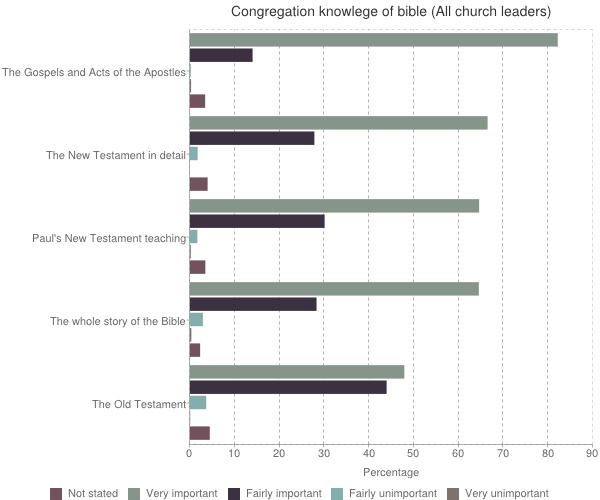
The use to which church leaders put the Bible
This graph shows the incidence of all church leaders, leaders from formal traditions, and leaders from informal traditions responding that they would always use the Bible in a variety of leadership related activities. Except in Public Prayer leaders from informal traditions are more likely to use the Bible than those from formal traditions, and in some areas the difference is particularly marked. For example informal leaders are 1.7 times more likely to use the Bible in small groups than their colleagues from formal traditions. This may be a sign that the role of all small groups in the different traditions is very different, or possibly that the leaders from the varying traditions interpreted the term ‘small group’ differently with informal leaders attaching this term predominantly to Bible study groups, while traditional leaders were prepared to use the term to encompass social action groups, fellowship groups, and other para-church organisations. However in other areas where the meaning of the descriptive term is unambiguous, for example ‘sermons’ and ‘evangelism’ informal leaders were 1.25 and 1.28 times more likely to use the Bible than their formal counterparts. The increased use of Scripture by informal leaders, who include Pentecostal denominations, was reflected in an ethnic bias towards black leaders using the Bible more frequently than their white counterparts. Breaking the results down further by denomination there were some striking results. URC and Methodist churches were respectively likely to always use the Bible during evangelism 19% and 26% of the time, and at the time of this research their attendance was falling sharply (and in the case of the URC still is).
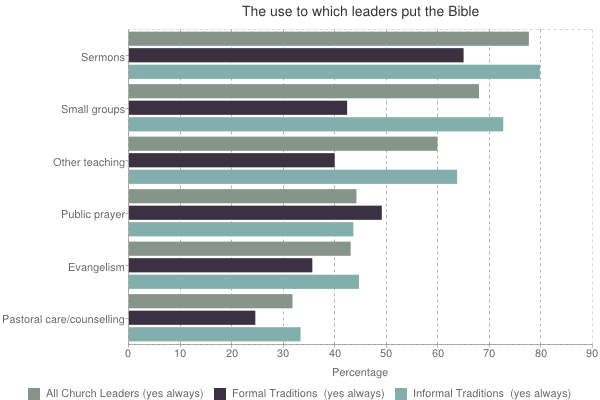
What version of the Bible is most used in Churches
Church leaders were asked what the Bible used most frequently in their church was. Their answers are show that the dominant translation in use in England and Wales is the NIV, used most of the time by 66% of all congregations. Among leaders of “formal” congregations the Jerusalem Bible dominates, reflecting, the near universal use of this translation among the Roman Catholic community, whereas among the leaders of other formal congregations usage was approximately equally divided between the NIV, the GNB, and the NRSV. These statistics show that 400 years after its first publication the KJV translation is passing from general use by leaders in the church even among congregations with a formal tradition. This is unsurprising since other parts of the study reported here show that the dominant reasons for preferring one translation over another are readability, followed by accuracy.
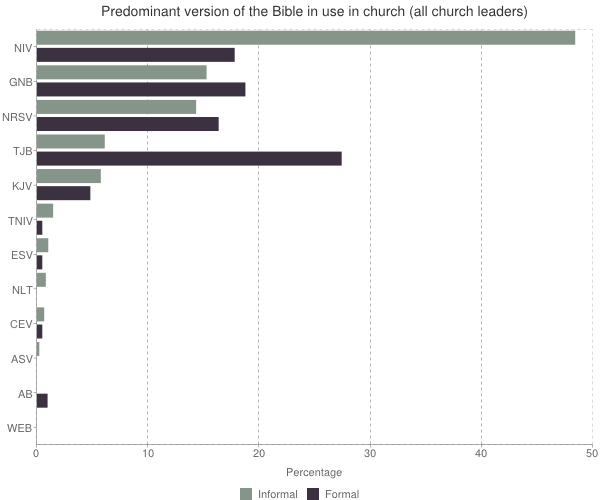
To what degree is the Bible the focus of teaching in Church
As might be expected, the overwhelming majority of Churches in England and Wales regularly teach from the Bible. There is a clear effect for informal leaders and congregations to report a higher incidence of teaching from the Bible than congregations and leaders with a formal tradition. This finding is compatible with the findings about what use church leaders put the Bible to, which also showed that leaders from a formal tradition were less likely to make use of scripture. There is also a trend for congregation members to believe that it is taught less than leaders report teaching it which could indicate that there is a response bias among leaders who would like to believe that they are teaching the from the Bible more regularly than they actually are. However there are other possible explanations, including that congregations do not recognise Bible based teaching for what it is when the references to the Bible are not explicit, or that the alertness of the congregation varies and there are periods where they are not attending to the course of the teaching, Bible based or otherwise.
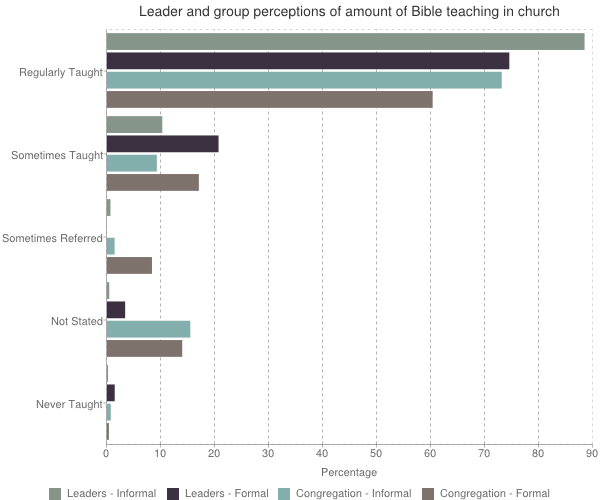
How the bible makes leaders and congregations feel
It is plain that both for leaders and congregations within formal and informal congregations reading the Bible excites mainly positive emotions. Leaders generally are more likely to experience most emotions than congregations. Since this is a retrospective study, where people are being asked to look back on what they believe that they think or feel, this could have several interpretations. It could mean that leaders are genuinely remembering more incidents where they experienced strong emotions while reading the Bible (which would be consistent with the finding that leaders are more likely than congregations to read the Bible daily). Alternatively it could be simply an effect of leadership whereby people who are leaders are more likely to be outgoing people who are enthusiastic. These data on emotional experience when reading the Bible may also serve as a proxy for which portions of the Bible are read regularly by leaders and congregations. If this were the case it would imply that people are much more likely to read affirming and positive pieces of Scripture than portions which are confusing, difficult, and which focus on scary attributes of God.
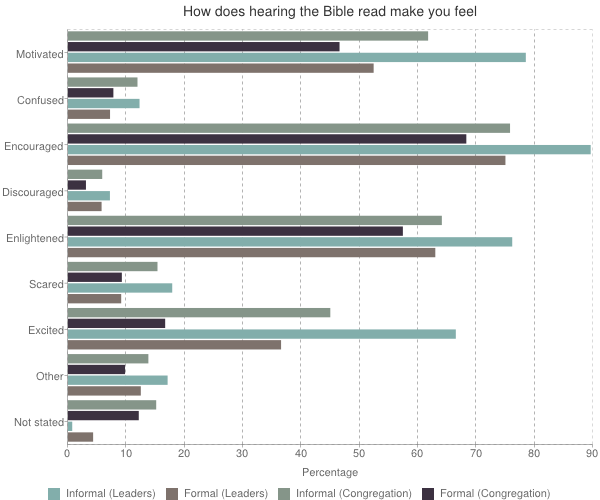
The Bible’s position in Society
Both formal and informal congregations believe that the Church should work towards a society which takes the Bible more seriously. Such a generally expressed intention is not always helpful, but in this case there is some allied data. Approximately 60% of formal and informal congregations agree that the Church should exert more influence in society, for example through the presence of the most senior Bishops in the House of Lords. More informal congregations (76%) than formal ones (69%) believe that the Church should work hard to promote Biblical principles across society. Preserving the same relation between formal and informal congregations between 55% and 65% of the sample believe that the development of Biblical public policy is desirable. Similar trends were observed in the leadership groups.
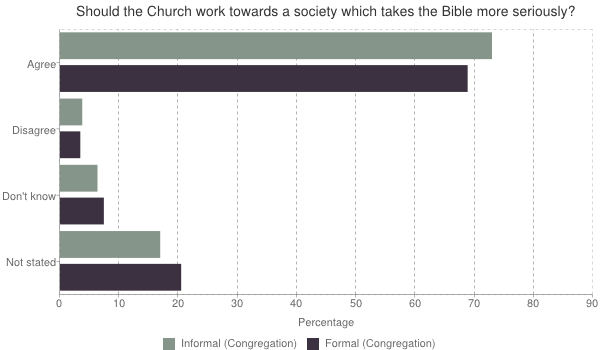
Caveat regarding weighting
Research study samples of population are always at least slightly imperfect, and it is usual practice to weight the raw data so that it conforms to a known population profile – in this case the 2005 Church Census. Ideally when weighting data one hopes to keep the factor used to adjust the scores reasonably small. In this case because the sample selected by the external agency who conducted the work was substantially imperfect, the weighting factors were rather larger than would normally be considered ideal. However, because of the unique nature of the data and the importance of its findings, we have decided to release this report on the work. We would urge readers to look to this research to garner understanding of the broad trends, and perhaps to design further research into these areas.
Bible facts and figures
Here are some interesting facts and figures about the Bible
The books of the Bible
The word 'Bible' comes from the Greek and Latin words which mean 'books' and 'the book'. This is because the Bible is a collection of books as well as a single book.
Although Christians largely agree on the number of books in the Bible, the exact number varies from one Church tradition to another.
- Most Protestant Christians recognise 66 books in the Bible
- Most Catholics recognise the 66 plus 7 deuterocanonical books, bringing the total to 73 books
- Greek Orthodox Bible has 75 books
- Ethiopian Orthodox Christians recognise 81 books in the Bible
Writing of the Bible
The Bible was initially spoken and then written over about 1300 years, roughly between 1200 and 100 AD.
The books were written in what is now Israel and Palestine, Egypt and different parts of the then Roman Empire.
There were over 40 writers of the Bible, including scribes, fishermen, kings, royal officials, prophets, musicians, secretaries and poets as well as the odd doctor or tree-surgeon.
The Bible contains many different types of documents: poetry, legal documents, songs, letters, eyewitness accounts, people stories, historical documents and advice material.
The Bible and languages
Originally, some of the Bible was written in Hebrew, some in Aramaic and some in Greek. Today, about 2,500 of the world’s 7000+languages have part of the Bible translated into them.
- The entire Bible is available in at least 426 languages
- The New Testament is available in 1,115 languages
However, over 4,500 languages still wait for even one book of the Bible. This means millions either have no access to the Bible at all or can only encounter it in something other than their ‘heart’ language.
The process of producing a translation of the Bible is slow, difficult and lengthy. Recently, computer-aided programmes have now reduced the time involved.
Bibles printed and sold
The Bible is by far the best-selling book of all time. However, no one can be absolutely sure exactly how many copies have been printed, sold or distributed.
Bible Society’s attempt to calculate the number printed between 1816 and 1975 produced the figure of 2,458,000,000 – almost 2 and a half billion.
Another survey, for the years up to 1992, put it closer to 6 billion.
The Bible is the most shop-lifted book in the world.
Well known phrases from the Bible (King James Version)
- All things to all men
- The blind leading the blind
- Can a leopard change its spots?
- A fly in the ointment
- The writing on the wall
Other Bible facts
- About 50 Bibles are sold every minute.
- A shepherd boy discovered old clay jars in a cave by the Dead Sea in 1947. The old jars contained dusty scrolls, which turned out to include ancient copies of the Old Testament.
- The oldest parable in the Bible is in Judges 9:8-15.
- The New Testament contains more than 260 Old Testament quotations, the majority from the Septuagint translation of the Hebrew Bible.
- The shortest book in the New Testament is 2 John with 13 verses.
- The longest book in the New Testament is Acts. It has 28 chapters. Matthew also has 28 chapters, but it is shorter.
- The New Testament has about 8,000 verses.
- The word Christian is first mentioned in the Bible in Acts 11:26. The word Christian is found in only two other places in the Bible: Acts 26:28 and 1 Peter 4:16.
- The shortest Old Testament book is Obadiah. It has 1 chapter with 21 verses.
- The shortest verse in the Old Testament is 1 Chronicles 1:25.
- The Old Testament has more than 60 passages which Christians believe are prophecies of Jesus.
- 'Do not be afraid' appears around 365 times in the Bible (depending on the translation, of course).
- A popular translation of The Bible contains around 774,000 words (depending on the version). It would take you approximately 70 hours to read the whole Bible out loud.
With many thanks to Bible Society for these facts and figures. For more information like this on the Bible and its history you may be interested to read the 'Bible Style Guide'. This was a document originally produced by Bible Society to help inform journalists about the Bible, but we think it is an excellent resource for a wider audience. You can download it from the Related downloads section.
{loadposition rt_download}
Back